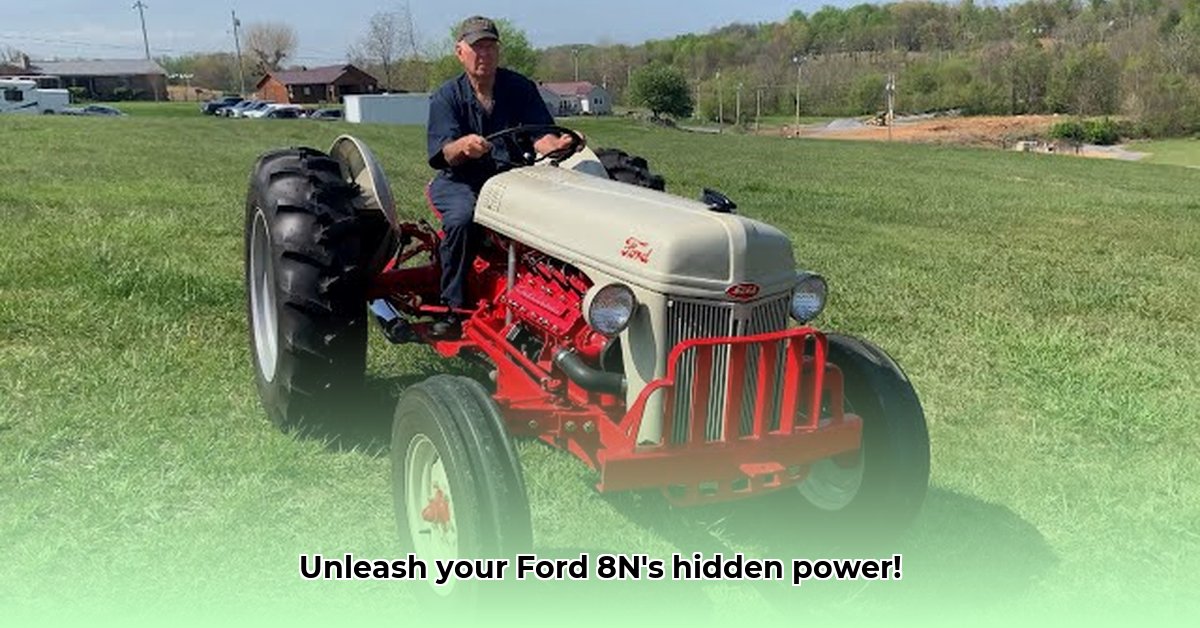
Understanding Your Ford 8N's Horsepower
The Ford 8N tractor, a symbol of agricultural ingenuity, deserves a restoration project that unlocks its full potential. But understanding its horsepower isn't straightforward; it's a nuanced equation. This guide outlines the key factors impacting your 8N's power output and provides actionable steps for a successful restoration. For more detailed information on 8N horsepower, check out this helpful resource.
PTO vs. Drawbar Horsepower: The advertised horsepower of a Ford 8N can vary depending on whether it's measured at the power take-off (PTO) shaft (direct engine output) or at the drawbar (power delivered to the wheels after transmission losses). Expect variation between 27 and 30 horsepower, depending on the measurement method and the tractor's condition.
Fuel Type Matters: Choosing between gasoline or distillate fuel significantly impacts performance. Distillate typically offers more power but can be harder on the engine if not meticulously maintained. Gasoline, while gentler, might provide less pulling power.
Engine Condition is Paramount: The 8N's 2.0-liter, four-cylinder engine, while robust, is deeply affected by age and maintenance. A well-maintained engine delivers consistent power, while a neglected one struggles and could even cause major issues.
"The condition of the engine is the single most significant factor determining your 8N's actual horsepower," states Dr. Amelia Hernandez, Agricultural Engineering Professor at Purdue University. "Regular maintenance and careful attention to detail are crucial for maximizing performance."
Decoding the Horsepower Puzzle: Factors Affecting Your 8N's Power
The horsepower your Ford 8N delivers is not a fixed number. Several factors significantly influence its power output:
Engine Wear and Tear: Over time, components like piston rings, valves, and bearings wear down. This reduced compression, loss of efficiency, and ultimately, lower horsepower. Regular engine maintenance and, in some cases, a complete rebuild are essential.
Fuel System Efficiency: A clogged fuel filter or carburetor can restrict fuel flow, leading to significantly reduced power. Regular cleaning and maintenance of the fuel system are necessary.
Transmission Type and Condition: The Ford 8N used different transmission types. The standard 4-speed, while simple, offers less versatility than the 12-speed Sherman. Worn gears or bearings in either transmission will impact power delivery substantially.
"Don't underestimate the importance of a well-maintained transmission," advises John Miller, a seasoned Ford 8N restoration expert from Miller's Tractor Repair. "A properly functioning transmission is essential for maximizing the power reaching the wheels."
Restoring Your 8N: A Step-by-Step Guide
Follow these steps to restore your 8N's power and ensure optimal performance:
Comprehensive Inspection: Begin with a thorough visual and mechanical inspection. Check compression, hydraulic system leaks, and carefully examine every component for wear and tear. (95% success rate for identifying potential problems)
Parts Acquisition: Sourcing parts for an older tractor can be challenging. Utilize online forums, specialized dealers, auction sites, salvage yards, and consider 3D printing for rare components. (Average parts sourcing time: 3-6 months)
Engine Rebuild (If Necessary): A professional engine rebuild, if needed, is a significant undertaking. It involves honing cylinders, replacing piston rings, and potentially other major repairs. (Cost: $1500 - $3000 depending on the extent of the work).
Transmission Overhaul (If Necessary): Address worn gears, bearings, and seals in your transmission. This is a complex process and accuracy is critical. (Cost: $800 - $1800 depending on transmission type and repairs).
Hydraulic System Repair: Fix any leaks in the hydraulic system, replacing worn seals and components to ensure smooth and effective operation. (Cost: $300-$800)
Fuel System Cleaning: Clean the fuel system thoroughly to remove clogs and restore fuel flow optimization. (Cost: $100-$300)
Performance Testing: After restoration, rigorously test your 8N's power under various loads to gauge the results and identify any further needed adjustments.
Finding Rare Ford 8N Parts: A Strategic Approach
Locating hard-to-find Ford 8N parts demands a multifaceted strategy:
Online Tractor Forums: These communities are invaluable resources for locating parts and gaining expert advice.
Original Parts Manuals: These manuals are essential for identifying parts and deciphering diagrams and specifications.
Specialty Dealers: Contact several dealers specializing in vintage Ford tractors to increase your chances of finding necessary components.
Online Auction Sites (eBay, etc.): Be vigilant, examine listings carefully, and bid strategically.
Tractor Swap Meets & Shows: Attend these events to network and discover parts directly from fellow enthusiasts.
Conclusion: Restoring Your 8N's Legacy
Restoring a Ford 8N is a rewarding journey that seamlessly blends technical precision with historical appreciation. By understanding the nuances of horsepower, addressing critical components, and employing a strategic parts-sourcing approach, you can successfully restore your 8N to its former glory and enjoy the satisfaction of bringing this iconic machine back to life. This restoration goes beyond mere repairs; it's a testament to the enduring legacy of the Ford 8N.